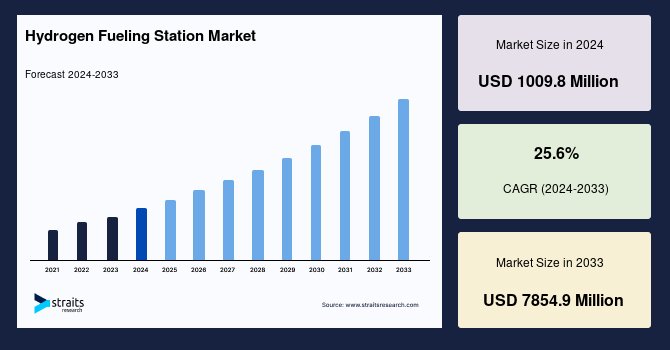The global hydrogen fueling station market is poised for significant growth, driven by increasing demand for zero-emission vehicles and supportive government policies. Valued at USD 1,009.8 million in 2024, the market is projected to expand from USD 1,268.3 million in 2025 to USD 7,854.9 million by 2033, registering a robust compound annual growth rate (CAGR) of 25.6% during the forecast period (2025-2033). This growth is fueled by the rising adoption of hydrogen fuel cell vehicles (FCVs) and the global push toward decarbonization.
Ask For Customization : https://straitsresearch.com/report/hydrogen-fueling-station-market/request-sample
Market Scope and Research Methodology
The hydrogen fueling station market analysis encompasses a comprehensive evaluation of market dynamics, including drivers, restraints, opportunities, and challenges. The research methodology involves a combination of primary and secondary data sources, including industry reports, government publications, and expert interviews. Market size estimations are based on historical data, current trends, and future projections, ensuring a holistic understanding of the market landscape.
The study period spans from 2021 to 2033, with 2024 as the base year. The forecast period (2025-2033) highlights the anticipated growth trajectory, supported by increasing investments in hydrogen infrastructure and technological advancements. The report also provides regional insights, segmentation analysis, and competitive benchmarking to offer a detailed view of the market.
Market Drivers
Governments worldwide are implementing policies to promote hydrogen fuel cell vehicles as part of their efforts to reduce carbon emissions and improve air quality. Incentives such as subsidies, tax credits, and grants are encouraging both consumers and automakers to adopt hydrogen-powered vehicles, thereby driving the demand for hydrogen fueling stations.
The growing awareness of environmental sustainability and the need for cleaner transportation options are accelerating the adoption of fuel cell electric vehicles (FCEVs). Hydrogen fuel cell vehicles produce only water vapor and heat as byproducts, making them an attractive alternative to traditional gasoline and diesel vehicles.
The increasing availability of FCEVs from major automakers such as Toyota, Honda, and Hyundai is a key factor driving market growth. The International Energy Agency (IEA) reported a 40% increase in the number of FCEVs on the road in 2022 compared to 2021, signaling a shift toward hydrogen-powered mobility.
Market Segmentation
- By Station Type:
- Small Stations: Designed for low-demand areas or niche markets, small stations are ideal for regions with limited hydrogen adoption.
- Medium Stations: Catering to moderate demand, these stations are typically deployed in urban or suburban areas.
- Large Stations: Built to serve high-demand regions, large stations are essential for supporting a growing fleet of FCEVs.
- By Vehicle Type:
- Passenger Cars: Hydrogen fueling stations for passenger vehicles are critical for promoting the adoption of FCEVs among individual consumers.
- Commercial Vehicles: Stations serving commercial vehicles, such as buses and trucks, play a vital role in decarbonizing the transportation sector.
Sample Copy of Research Report : https://straitsresearch.com/report/hydrogen-fueling-station-market/request-sample
Regional Insights
- Asia-Pacific: The largest market for hydrogen fueling stations, Asia-Pacific is expected to grow at a CAGR of 25.7%. Countries like China, Japan, and South Korea are leading the way with ambitious hydrogen infrastructure plans and strong government support.
- Europe: The fastest-growing region, Europe is projected to achieve a CAGR of 25.9%. The European Union’s hydrogen strategy and initiatives like Germany’s H2 Mobility program are driving market growth.
- North America: Supported by tax incentives and technological advancements, North America is witnessing significant growth in hydrogen fueling infrastructure. The United States aims to produce 50 million tons of clean hydrogen annually by 2050.
- Middle East and Africa: Countries like Saudi Arabia and the UAE are investing in hydrogen infrastructure as part of their efforts to diversify energy sources and reduce carbon emissions.
Key Players
- Air Liquide
- Air Products and Chemicals, Inc.
- Linde plc
- Nel ASA
- McPhy Energy S.A.
- Ingersoll Rand
- Hydrogen Refueling Solutions
- PERIC Hydrogen Technologies Co. Ltd
- Chart Industries
- Iwatani Corporation
Conclusion
The global hydrogen fueling station market is on a rapid growth trajectory, driven by the increasing adoption of FCEVs and supportive government policies. While high initial costs and infrastructure challenges remain, technological advancements and strategic investments are expected to overcome these barriers. With Asia-Pacific leading the market and Europe emerging as the fastest-growing region, the future of hydrogen fueling stations looks promising, paving the way for a cleaner and more sustainable transportation ecosystem.



